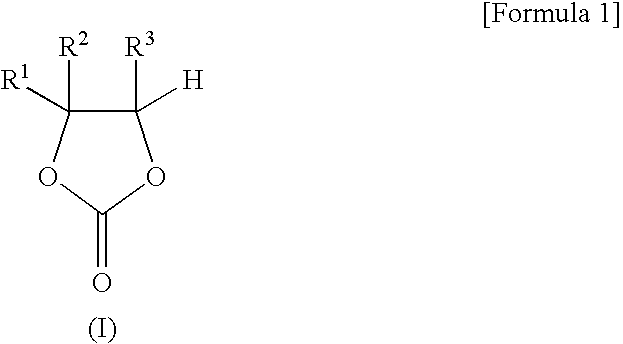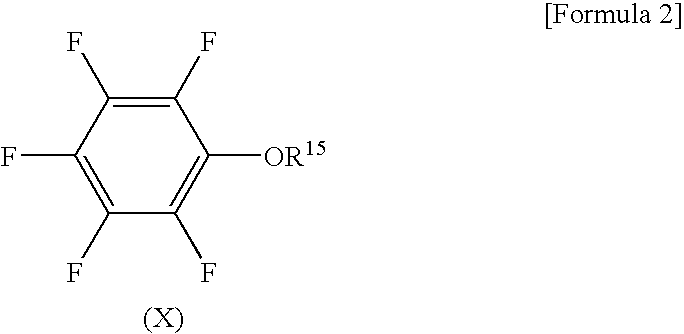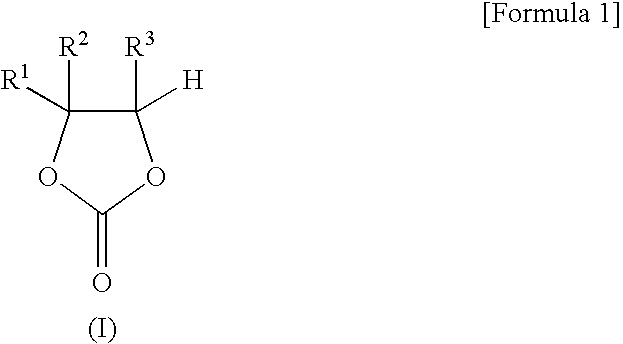Nonaqueous electrolyte solution and lithium secondary battery using same
a technology of nonaqueous electrolyte and lithium secondary battery, which is applied in the direction of non-aqueous electrolyte cells, cell components, electrochemical generators, etc., can solve the problems of battery performance reduction, battery performance reduction, battery performance reduction, etc., and achieve excellent battery performance, cycle property and storage property, and excellent battery characteristics
- Summary
- Abstract
- Description
- Claims
- Application Information
AI Technical Summary
Benefits of technology
Problems solved by technology
Method used
Image
Examples
example 1
Preparation of Nonaqueous Electrolytic Solution
[0133]A nonaqueous solvent of EC:MEC:DEC=3:4:3 (volume ratio) was prepared, in which LiPF6 as an electrolyte salt was dissolved to a concentration of 1 M to obtain a nonaqueous electrolytic solution. To the nonaqueous electrolytic solution were added fluoroethylene carbonate (FEC) to a concentration of 2% by weight and, further, 2-propynyl methyl carbonate as an alkyne derivative to a concentration of 1% by weight based on the final nonaqueous electrolytic solution.
[Manufacture of Lithium Secondary Battery and Measurement of Battery Characteristics]
[0134]Ninety-four % by weight of LiCo1 / 3Ni1 / 3Mn1 / 3Mn1 / 2 (positive electrode active material), 3% by weight of acetylene black (conductive material) and 3% by weight of polyvinylidene fluoride (binder) were mixed, to which 1-methyl-2-pyrrolidone as a solvent was further added and mixed. The resulting mixture was applied onto an aluminum foil, dried, compression molded and heat treated to prepa...
examples 2 to 9
[0137]Examples 2 to 9 were conducted in the same manner as described in Example 1 except that alkyne derivatives shown in Table 1 were used in predetermined amounts in place of 2-propynyl methyl carbonate. The results are also summarized in Table 1.
example 10
[0138]Example 10 was conducted in the same manner as described in Example 1 except that, after the same nonaqueous electrolytic solution as that in Example 1 had been prepared, vinylethylene carbonate (VEC) and di(2-propynyl) sulfite were added thereto in amounts of 2% by weight and 0.5% by weight, respectively, based on the final nonaqueous electrolytic solution. The results are summarized in Table 1.
PUM
| Property | Measurement | Unit |
|---|---|---|
| dew point | aaaaa | aaaaa |
| dew point | aaaaa | aaaaa |
| temperature | aaaaa | aaaaa |
Abstract
Description
Claims
Application Information
 Login to View More
Login to View More - R&D
- Intellectual Property
- Life Sciences
- Materials
- Tech Scout
- Unparalleled Data Quality
- Higher Quality Content
- 60% Fewer Hallucinations
Browse by: Latest US Patents, China's latest patents, Technical Efficacy Thesaurus, Application Domain, Technology Topic, Popular Technical Reports.
© 2025 PatSnap. All rights reserved.Legal|Privacy policy|Modern Slavery Act Transparency Statement|Sitemap|About US| Contact US: help@patsnap.com



